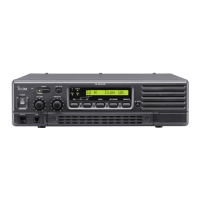3 - 6
Description
The voltage from the DC power unit (CHASSIS;
EP1).
The same voltage as the PS 15V line which is
controlled by the power switch.
Common 9 V for converted from the VCC1 line
by the M9V regulator circuit (REG unit; IC1, Q8,
Q9). The voltage is applied to the TX and RX
units.
Common 9 V converted from the VCC1 line by
the L9V regulator circuit (REG unit; IC2).
Common 5 V converted from the L9V line by the
A5V regulator circuit (REG unit; IC3).
Common 5 V converted from the L9V line by the
L5V regulator circuit (LOGIC unit; IC38, Q48,
D43).
Common 5 V converted from the L9V line by the
C5V regulator circuit (LOGIC unit; IC38, Q45,
D13).
Common 5 V converted from the M9V line by the
TEL5V regulator circuit (LOGIC unit; IC11).
Line
PS 15V
VCC1
M9V
L9V
A5V
L5V
C5V
TEL5V
3-5 POWER SUPPLY CIRCUITS
3-5-1 LOGIC AND REG UNITS VOLTAGE LINES
Description
Transmit 5 V converted from the M9V line by the
T5V regulator circuit (TX unit; IC1).
Transmit 6 V converted from the M9V line by the
T6V regulator circuit (TX unit; IC4).
Common 9 V converted from the M9V line by the
V9V regulator circuit (TX unit; Q6).
Line
T5V
T6V
V9V
3-5-3 TX UNIT VOLTAGE LINES
Description
Common 5 V converted from the M9V line by the
+5V regulator circuit (RX unit; IC3).
Common 6 V converted from the M9V line by the
+6V regulator circuit (RX unit; IC7).
Receive 5 V converted from the R9V line by the
R5V regulator circuit (RX unit; IC6).
Receive 9 V controlled by the R9V regulator cir-
cuit (RX unit; Q15) using “R9C” signal from IC39
(LOGIC unit).
The same voltage as the M9V.
Line
+5V
+6V
R5V
R9V
V9V
3-5-2 RX UNIT VOLTAGE LINES
AF signals from J13 (FRONT unit) are applied to the network
IC (IC46). The output signals from IC46 (pins 8, 9) are
applied the AF amplifier IC (IC1, pin 2) via “T8” signal. The
signals pass through the MIC mute switch, the MIC mixer
amplifier, the pre-emphasis circuit, the high-pass filter, limiter
amplifier circuit, S-mixer circuit, and splatter filter circuit. The
filtered signals are applied to the TX unit.
After off-hook condition, DTMF signal from telephone line is
applied to the decoder IC (IC31) to decode the DTMF signal.
The DTMF signal is applied to the CPU (IC33) via serial data
signal line.
The clear down signal is detected at IC45, and is then
applied to the CPU (IC33). The “HOOKC” signal from the
CPU (IC33, pin 72) and the “DP” signal from IC47 are
applied to the hook switch (RL1, RL2) to on-hook.
3-4-2 EEPROM CIRCUIT (LOGIC UNIT)
The detector IC (IC34) detects power supply ON-OFF volt-
age. The signal from IC34 is applied to IC33 (CPU). IC35,
IC36 are reset signal circuit which stabilizes to memory for
the EEPROM (IC37).
the EEPROM (IC37) memories clone data, adjust setting
condition data etc.
3-4-3 TEMPERATURE DETECT CIRCUIT
(LOGIC UNIT)
The temperature detect circuit protects the power amplifier
and power supply circuit from high temperature and stabi-
lizes the output power.
Inside temperature of the PA unit is detected at D1 (VARIS-
TOR unit) and is then applied to the amplifier (PA unit; IC4).
The amplified signal is applied to the CPU (IC33) to analyze
the temperature via IC32.
Inside temperature of the REG unit is detected at D6 (REG
unit) and is then applied to the amplifier (REG unit; IC9). The
amplified signal applied to the CPU (IC33) to analyze the
temperature via IC32.
IC32 selects “PATEMP” or “REGTEMP” signals from the PA
or REG unit.

